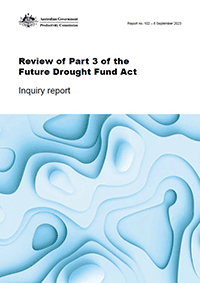Future Drought Fund
Review of Part 3 of the Future Drought Fund Act
Inquiry report
Released 26 / 09 / 2023
This inquiry report examines the effectiveness, efficiency and appropriateness of Part 3 of the Future Drought Fund Act 2019. Part 3 covers the processes for allocating funding to activities that support drought resilience.

Key points
- Drought and climate change are expected to put Australia’s agricultural industries and regional communities under mounting economic, environmental and social pressure. The Future Drought Fund (FDF) could be a catalyst for locally led transformational change to meet these pressures.
- Despite early challenges, the FDF is establishing a solid foundation for building drought resilience. The first years have revealed opportunities to improve the design and delivery of the Fund’s programs, including through identifying gaps in existing resilience programs, more planning around how the FDF will prioritise programs and improved knowledge sharing.
- A stronger focus on activities that generate lasting public benefits is needed. The FDF should focus on activities that generate transformational change, build natural capital, and support a place-based approach to building social resilience.
- Drought is just one of the risks from climate change that farmers and agricultural communities face. While drought should remain the focus, the FDF should explicitly recognise climate change resilience to confirm that, where appropriate, programs address a broader range of climatic risks.
- Establishing an Aboriginal and Torres Strait Islander working group to partner with the Department of Agriculture, Fisheries and Forestry could improve the design and implementation of the Fund for the benefit of Aboriginal and Torres Strait Islander people.
- A number of FDF programs can be improved by:
- consolidating the climate information tools into a single tool, tailored to the needs of end users
- clarifying ownership, governance and funding for regional drought resilience plans
- tightening eligibility and increasing support for natural resource management and transformational practices in the Farm Business Resilience program
- supporting transformational change through the Drought Resilience Innovation Grants program by piloting a challenge-based approach to innovation
- clarifying the role of the Drought Resilience Adoption and Innovation Hubs followed by a mid-term review of their performance
- strengthening the links between regional planning and community grant funding to ensure a strategic, place-based approach to building social resilience.
Contents
- Preliminaries: Cover, Copyright and publication detail, Transmittal letter, Terms of reference, Contents, and Acknowledgements
- Overview
- A Fund to advance drought resilience
- Governments’ role in building resilience
- Opportunities for improvement in the next Funding Plan
- Improving key programs
- The next four years
- Recommendations and findings
- 1. What is this inquiry about?
- 1.1 What has the Productivity Commission been asked to do?
- 1.2 Conduct of the inquiry
- 1.3 Context for this inquiry
- 1.4 Building resilience in the face of climate change
- 1.5 The Commission’s approach
- 2. How has the Future Drought Fund performed?
- 2.1 Assessing the appropriateness of the Fund and its programs
- 2.2 Assessing the design and delivery of the Fund and its programs
- 3. The next steps for the Future Drought Fund
- 3.1 Focusing on activities delivering the greatest benefits
- 3.2 Strengthening the design and delivery of the Fund
- 3.3 More explicit recognition of climate change
- 3.4 Improving opportunities for knowledge sharing
- 4. Are the governance arrangements fit for purpose?
- 4.1 Future Drought Fund governance is broadly appropriate
- 4.2 The Regional Investment Corporation Board’s role should be removed
- 4.3 The timing of the Productivity Commission review should be amended
- 4.4 The role of the Department
- 4.5 The role of the Consultative Committee
- 5. Monitoring, evaluation and learning
- 5.1 Why do monitoring, evaluation and learning?
- 5.2 Progress on FDF monitoring, evaluation and learning activities
- 5.3 Developing and implementing MEL activities has been challenging
- 5.4 Opportunities to improve the MEL system
- 5.5 Building capability and capacity for MEL
- 5.6 Learning could more systematically inform program design and implementation
- 6. Improving outcomes for Aboriginal and Torres Strait Islander people
- 6.1 Aboriginal and Torres Strait Islander people are active participants but are underrepresented in the agricultural sector
- 6.2 The FDF has potential to benefit Aboriginal and Torres Strait Islander people and the wider agricultural sector
- 6.3 How have Aboriginal and Torres Strait Islander people participated in the FDF to date?
- 6.4 What improvements could be considered?
- 7. Review of Fund programs
- 7.1 Better Climate Information
- 7.2 Better Planning
- 7.3 Better Practices
- 7.4 Better Prepared Communities
- A. Public engagement
- Abbreviations
- References
Printed copies
Printed copies of this report can be purchased from Canprint Communications.
We value your comments about this publication and encourage you to provide feedback.